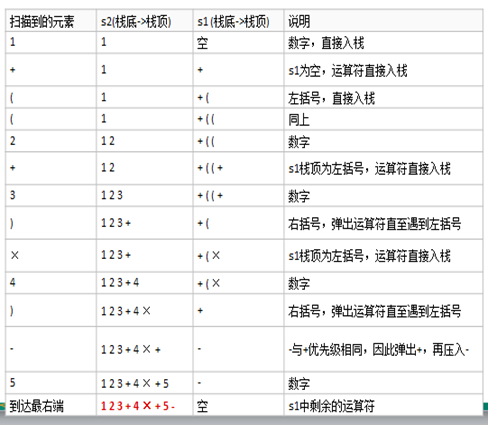前缀、中缀、后缀表达式 一、前缀表达式 前缀表达式是一种没有括号的算术表达式,与中缀表达式不同的是,其将运算符写在前面,操作数写在后面 。也被叫做波兰表达式,比如(499 + 1)* 2 + 314 的前缀表达式为 + * + 499 1 2 314
前缀表达式的计算机求值 求值方法:
从右至左扫描表达式,遇到数字时,将数字压入栈,遇到运算符时,弹出栈顶的两个数,用运算符对它们做相应的计算(栈顶元素 和 次顶元素),并将结果入栈;重复上述过程直到表达式最左端,最后运算得出的值即为表达式的结果
举栗子🌰🌰(499 + 1)* 2 + 314 对应的前缀表达式就是 + * + 499 1 2 314, 针对前缀表达式求值步骤如下:
从右至左扫描,将314、2、1、499压入堆栈
遇到+运算符,因此弹出499和1(499为栈顶元素,1为次顶元素),计算499 + 1的值,得500,再将500入栈
接下来是 * 运算符,因此弹出500和2(500为栈顶元素,2为次顶元素),计算500 * 2的值,得1000,再将1000入栈
最后是+运算符,计算出1000 + 314的值,即1314💝💝,由此得出最终结果
二、中缀表达式 中缀表达式是一个通用的算术或逻辑公式表示方法, 操作符是以中缀形式处于操作数的中间 ,中缀表达式是人们常用的算术表示方法,比如(499 + 1)* 2 + 314
中缀表达式的计算机求值 可看另一篇文章,栈实现中缀表达式计算机
栈实现中缀表达式计算机
三、后缀表达式 逆波兰式(或逆波兰记法),也叫后缀表达式,其将运算符写在操作数之后 ,后缀表达式源自于前缀表达式,为了区分前缀和后缀表示,通常将后缀表示称为逆波兰表示。比如:(499 + 1)x 2 + 314 的后缀表达试为 499 1 + 2 x 314 +
后缀表达式的计算机求值 求值方法:
从左至右扫描表达式,遇到数字时,将数字压入堆栈,遇到运算符时,弹出栈顶的两个数,用运算符对它们做相应的计算(次顶元素 和 栈顶元素),并将结果入栈;重复上述过程直到表达式最右端,最后运算得出的值即为表达式的结果。
举栗子🌰🌰(499 + 1)* 2 + 314 对应的后缀表达式就是 499 1 + 2 * 314 +, 针对前缀表达式求值步骤如下:
从左至右扫描,将499和1压入堆栈;
遇到+运算符,因此弹出499和1(1为栈顶元素,499为次顶元素),计算出499+1的值,得500,再将500入栈;
将2入栈;
接下来是 * 运算符,因此弹出500和2,计算出500 * 2,得1000,再将1000入栈;
将314入栈;
最后是+运算符,计算出1000+314的值,即1314💗💗,由此得出最终结果
代码实现:
1 2 3 4 5 6 7 8 9 10 11 12 13 14 15 16 17 18 19 20 21 22 23 24 25 26 27 28 29 30 31 32 33 34 35 36 37 38 39 40 41 42 43 44 45 46 47 48 49 50 51 52 53 54 55 56 57 58 59 60 61 62 63 64 65 66 67 68 69 70 71 72 73 74 75 import java.util.ArrayList;import java.util.Collections;import java.util.List;import java.util.Stack;public class PolandNotation public static void main (String[] args) String suffixExpression = "499 1 + 2 * 314 +" ; List<String> list = getListString(suffixExpression); int res = calculate(list); System.out.println("计算的结果是: " + res); } public static List<String> getListString (String suffixExpression) String[] split = suffixExpression.split(" " ); List<String> list = new ArrayList<String>(); for (String element: split) list.add(element); return list; } public static int calculate (List<String> ls) Stack<String> stack = new Stack<String>(); for (String item: ls) { if (item.matches("\\d+" )) { stack.push(item); } else { int num2 = Integer.parseInt(stack.pop()); int num1 = Integer.parseInt(stack.pop()); int res = 0 ; if (item.equals("+" )) { res = num1 + num2; } else if (item.equals("-" )) { res = num1 - num2; } else if (item.equals("*" )) { res = num1 * num2; } else if (item.equals("/" )) { res = num1 / num2; } else { throw new RuntimeException("运算符有误" ); } stack.push("" + res); } } return Integer.parseInt(stack.pop()); } }
结果展示:
中缀表达式转为后缀表达式 转换算法步骤 📋👇
初始化两个栈:运算符栈s1和储存中间结果的栈s2;
从左至右扫描中缀表达式;
遇到操作数时,将其压s2栈;
遇到运算符时,比较其与s1栈顶运算符的优先级:
4.1.如果s1为空,或栈顶运算符为左括号“ ( ”,则直接将此运算符入栈;
4.2.否则,若优先级比栈顶运算符的高,也将运算符压入s1;
4.3.否则,将s1栈顶的运算符弹出并压入到s2中,再次转到(4.1)与s1中新的栈顶运算符相比较;
遇到括号时:
重复步骤2至5,直到表达式的最右边
将s1中剩余的运算符依次弹出并压入s2
依次弹出s2中的元素并输出,结果的逆序即为中缀表达式对应的后缀表达式
注:中缀表达式转为前缀表达式是从又往左扫描中缀表达式,核心算法思想相同 😄😄
实例分析
将中缀表达式1+((2+3)*4)-5转换为前缀表达式。
按照步骤最终结果为:1 2 3 + 4 * + 5 -
代码实现
1 2 3 4 5 6 7 8 9 10 11 12 13 14 15 16 17 18 19 20 21 22 23 24 25 26 27 28 29 30 31 32 33 34 35 36 37 38 39 40 41 42 43 44 45 46 47 48 49 50 51 52 53 54 55 56 57 58 59 60 61 62 63 64 65 66 67 68 69 70 71 72 73 74 75 76 77 78 79 80 81 82 83 84 85 86 87 88 89 90 91 92 93 94 95 96 97 98 99 100 101 102 103 104 105 106 107 class Operation public static int getValue (String operation) int result = 0 ; int ADD = 1 ; int SUB = 1 ; int MUL = 2 ; int DIV = 2 ; switch (operation) { case "+" : result = ADD; break ; case "-" : result = SUB; break ; case "*" : result = MUL; break ; case "/" : result = DIV; break ; default : System.out.println("不存在该运算符" + operation); break ; } return result; } } public static List<String> toInfixExpression (String s) List<String> ls = new ArrayList<String>(); int i = 0 ; String str; char c; do { if ((c = s.charAt(i)) < 48 || (c = s.charAt(i)) > 57 ) { ls.add("" + c); i++; } else { str = "" ; while (i < s.length() && (c = s.charAt(i)) >= 48 && (c = s.charAt(i)) <= 57 ) { str += c; i++; } ls.add(str); } }while (i < s.length()); return ls; } public static List<String> parseSuffixExpressionList (List<String> ls) Stack<String> s1 = new Stack<String>(); List<String> s2 = new ArrayList<String>(); for (String item : ls) { if (item.matches("\\d+" )) { s2.add(item); } else if (item.equals("(" )) { s1.push(item); } else if (item.equals(")" )) { while (!s1.peek().equals("(" )) { s2.add(s1.pop()); } s1.pop(); } else { while (s1.size() != 0 && Operation.getValue(s1.peek()) >= Operation.getValue(item) ) { s2.add(s1.pop()); } s1.push(item); } } while (s1.size() != 0 ) { s2.add(s1.pop()); } return s2; }
然后结合着后缀表达式的求值,便可实现完整的逆波兰计算器!📅📅
加油😘😘



